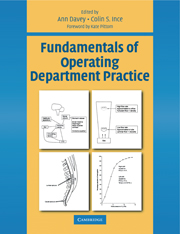Book contents
- Frontmatter
- Contents
- Contributors
- Preface
- Foreword
- Acknowledgements
- Introduction
- Chapter 1 The operating department practitioner, the patient and the law
- Chapter 2 Aspects of health and safety in the operating department
- Chapter 3 The caring practitioner
- Chapter 4 Strategies for infection control in the operating department
- Chapter 5 Sterilization, decontamination and the surgical field
- Chapter 6 The fundamentals of cardiovascular physiology
- Chapter 7 Fundamentals of respiratory physiology
- Chapter 8 Scientific principles in relation to the anaesthetic machine
- Chapter 9 Fundamentals of artificial ventilation of the lung
- Chapter 10 Scientific principles in relation to monitoring equipment
- Chapter 11 Scientific principles in relation to endoscopic, laser and radiological equipment
- Chapter 12 Pharmacological principles of drug administration
- Chapter 13 The pharmacology of drugs used in general anaesthesia
- Chapter 14 The local anaesthetic drugs - does the ideal agent exist?
- Chapter 15 The safe positioning of patients for surgery
- Chapter 16 Principles involved in the management and use of equipment
- Chapter 17 Understanding suture materials
- Chapter 18 Fundamentals ofpaediatric surgery and anaesthesia
- Chapter 19 Fundamentals of hyperthermia and hypothermia
- Chapter 20 Fundamentals of fluid and electrolyte balance during surgery
- Chapter 21 The physiology of blood and its administration
- Chapter 22 Fundamentals of pain relief
- Chapter 23 Fundamentals of dressings and drains in relation to wound healing
- Chapter 24 The recovery of patients from anaesthesia and surgery
- Chapter 25 Fundamentals of emergency and obstetric anaesthesia
- Chapter 26 Identification and management of anaesthetic emergencies
- Chapter 27 The fundamentals of emergency resuscitation
- Appendixes
- Index
Chapter 13 - The pharmacology of drugs used in general anaesthesia
Published online by Cambridge University Press: 05 October 2015
- Frontmatter
- Contents
- Contributors
- Preface
- Foreword
- Acknowledgements
- Introduction
- Chapter 1 The operating department practitioner, the patient and the law
- Chapter 2 Aspects of health and safety in the operating department
- Chapter 3 The caring practitioner
- Chapter 4 Strategies for infection control in the operating department
- Chapter 5 Sterilization, decontamination and the surgical field
- Chapter 6 The fundamentals of cardiovascular physiology
- Chapter 7 Fundamentals of respiratory physiology
- Chapter 8 Scientific principles in relation to the anaesthetic machine
- Chapter 9 Fundamentals of artificial ventilation of the lung
- Chapter 10 Scientific principles in relation to monitoring equipment
- Chapter 11 Scientific principles in relation to endoscopic, laser and radiological equipment
- Chapter 12 Pharmacological principles of drug administration
- Chapter 13 The pharmacology of drugs used in general anaesthesia
- Chapter 14 The local anaesthetic drugs - does the ideal agent exist?
- Chapter 15 The safe positioning of patients for surgery
- Chapter 16 Principles involved in the management and use of equipment
- Chapter 17 Understanding suture materials
- Chapter 18 Fundamentals ofpaediatric surgery and anaesthesia
- Chapter 19 Fundamentals of hyperthermia and hypothermia
- Chapter 20 Fundamentals of fluid and electrolyte balance during surgery
- Chapter 21 The physiology of blood and its administration
- Chapter 22 Fundamentals of pain relief
- Chapter 23 Fundamentals of dressings and drains in relation to wound healing
- Chapter 24 The recovery of patients from anaesthesia and surgery
- Chapter 25 Fundamentals of emergency and obstetric anaesthesia
- Chapter 26 Identification and management of anaesthetic emergencies
- Chapter 27 The fundamentals of emergency resuscitation
- Appendixes
- Index
Summary
INTRODUCTION
WHY ARE SO MANY DRUGS INVOLVED IN ANAESTHESIA?
In the early days of the development of anaesthesia, a single anaesthetic agent such as ether or chloroform was used throughout the operation. The agent would be used to both induce and maintain anaesthesia and would be administered in most types of surgery. This situation was complicated by the side effects of the anaesthetic agents, which would be dangerous if large doses were used. As the development of new anaesthetic agents progressed, it became apparent that it was possible to use several agents to provide anaesthesia, thus limiting the dose of any single agent. This balanced anaesthesia is based on the use of several agents, each of which is given to achieve a particular component of the desired anaesthetic effect.
WHAT IS THE TRIAD OF ANAESTHESIA?
The concept of a ‘triad’ of anaesthesia was developed to describe the three basic requirements of an anaesthetic that must be achieved during anaesthesia to ensure a successful outcome. These three conditions are:
Hypnosis.
Analgesia.
Relaxation
and are provided by the use of a ‘balanced’ combination of anaesthetic and other agents.
Hypnosis is the general term used in this context to describe alterations in the patient's consciousness. In the case of general anaesthesia, this obviously means the patient is rendered unconscious. During operations performed under local anaesthesia, however, a sedative may be given to produce a state of drowsiness and this effect is also included under the general ‘hypnosis’ part of the triad.
The analgesia component of the triad has two related meanings. It refers to the use of drugs and other techniques that ensure the patient recovers with as little pain as possible and also to the suppression of physiological reflexes that occur following surgical stimulation. A penetrating wound, such as a surgical incision, would cause a complex series of physiological responses if made in a conscious subject, including a dramatic increase in heart rate and blood pressure, hyperventilation, sweating and vomiting. The ‘analgesia’ component of the triad comprises those drugs and manoeuvres designed to limit these physiological responses to surgical stimulation. In many situations, this reflex suppression is achieved by the use of powerful narcotic analgesics.
- Type
- Chapter
- Information
- Fundamentals of Operating Department Practice , pp. 141 - 158Publisher: Cambridge University PressPrint publication year: 1999

